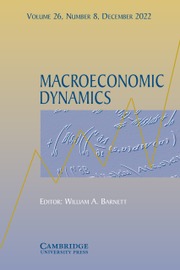No CrossRef data available.
Article contents
Average inflation targeting: welfare and fiscal multiplier
Published online by Cambridge University Press: 01 October 2025
Abstract
This paper examines the effects of average inflation targeting (AIT) on social welfare and fiscal multipliers under varying averaging windows using a nonlinear New Keynesian model. While the existing literature highlights AIT’s advantages over Inflation Targeting(IT) and longer-window AIT over shorter-window AIT in terms of social welfare, these conclusions often rely on linearized models that fail to capture expectation effects arising from window lengths. By solving the model nonlinearly, we find that social welfare increases with AIT windows up to six years but declines for longer windows. The key driver is the differing expectation effects, where longer windows reduce the likelihood of the zero lower bound (ZLB) binding but may overshoot inflation targets, leading to lower output and welfare. Our results reveal that the optimal averaging window for AIT depends critically on the ZLB probability: higher ZLB risks favor longer windows, while lower risks make shorter windows sufficient. Moreover, we investigate the fiscal multiplier under AIT and show that it differs significantly from IT. In addition, the welfare-maximizing AIT window does not align with the window that maximizes fiscal multipliers, highlighting trade-offs between welfare and fiscal policy effectiveness. This study underscores the importance of nonlinear methods in evaluating AIT and provides practical insights into its calibration for modern monetary policy frameworks.
Information
- Type
- Articles
- Information
- Copyright
- © The Author(s), 2025. Published by Cambridge University Press

